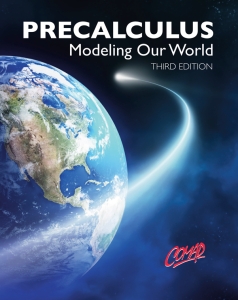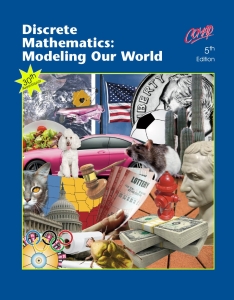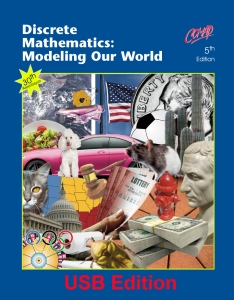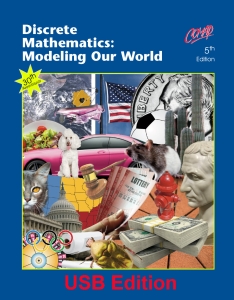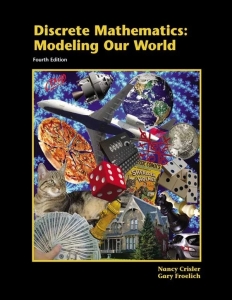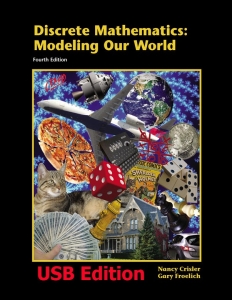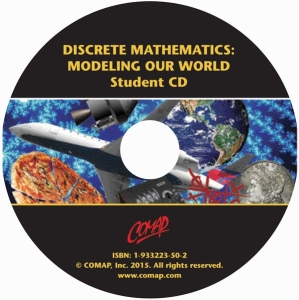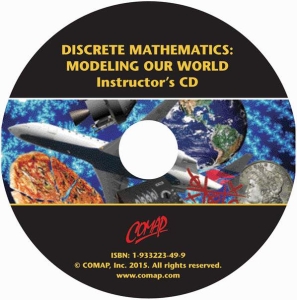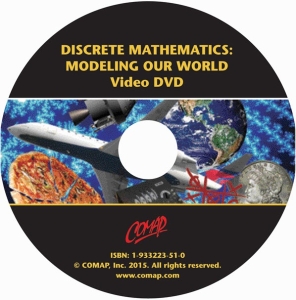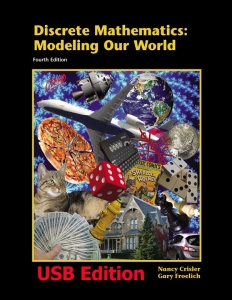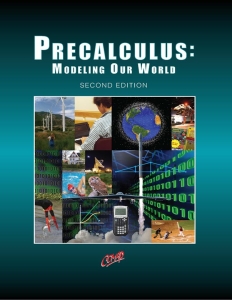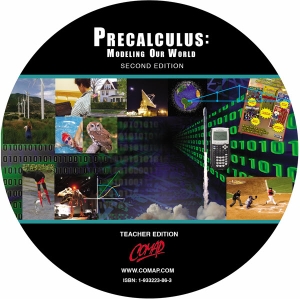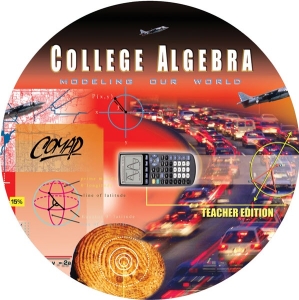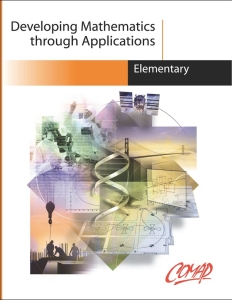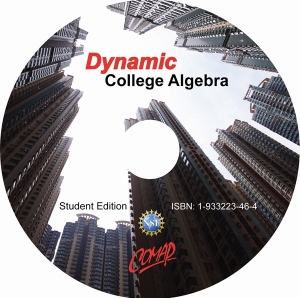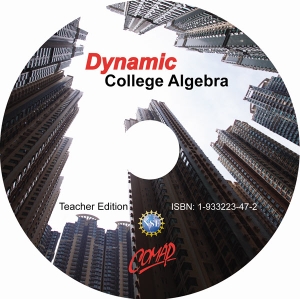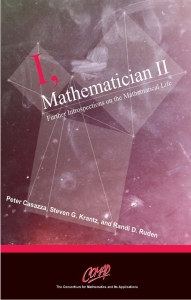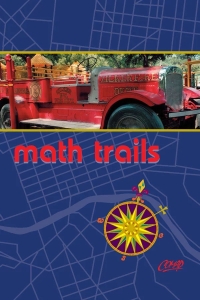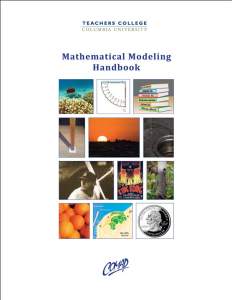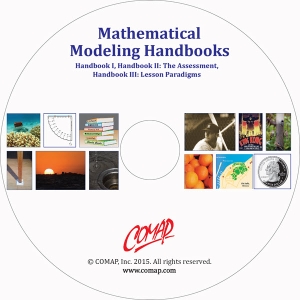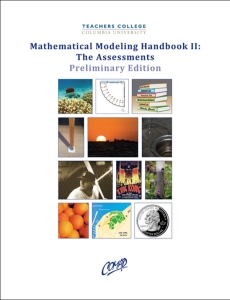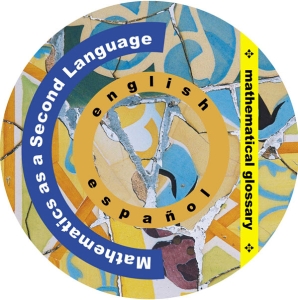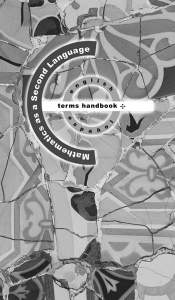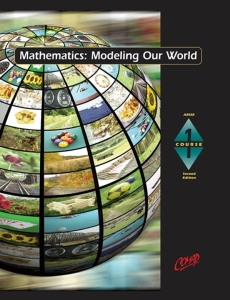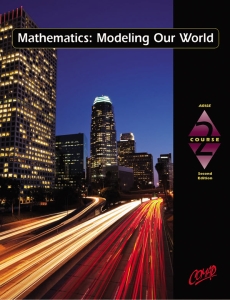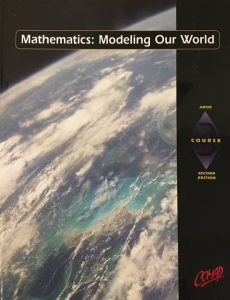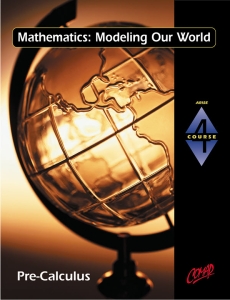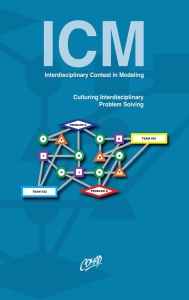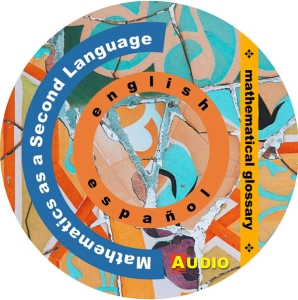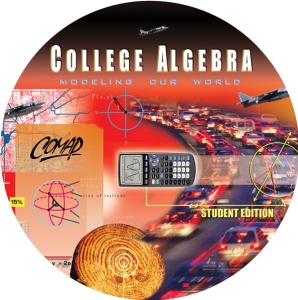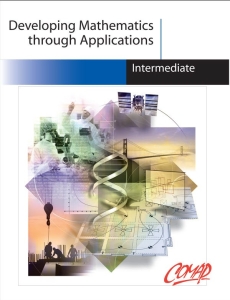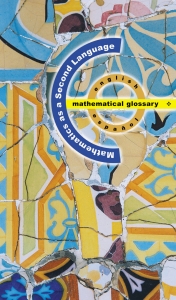COMAP Bookstore
COMAP’s bookstore offers all of our “for sale” products from the Teachers College Mathematical Modeling Handbook to our Discrete Mathematics: Modeling Our World and Precalculus: Modeling Our World textbooks.
For assistance with ordering any of our resources and products, email us at
Looking for Something Specific?
Precalculus: Modeling Our World 3rd Edition (Student Edition) (Print)
An exciting textbook, Precalculus: Modeling Our World develops mathematics through contemporary applications and mathematical modeling to motivate students. Student-centered activities engage students in explorations of important mathematical ideas. Technology, data analysis, and problem-solving strands help students develop skills necessary for success in the modern world.
Discrete Mathematics : Modeling Our World 5th Edition (Student Edition) (Print)
Written specifically for high school courses, Discrete Mathematics: Modeling Our World is a new fifth edition of the formerly titled Discrete Mathematics Through Applications. It is designed to help you implement mathematical modeling in your classroom, in a way that promotes active learning, critical thinking, and fully-engaged student participation.
Discrete Mathematics : Modeling Our World 5th Edition (Student Edition) (USB)
Written specifically for high school courses, Discrete Mathematics: Modeling Our World is a new fifth edition of the formerly titled Discrete Mathematics Through Applications. It is designed to help you implement mathematical modeling in your classroom, in a way that promotes active learning, critical thinking, and fully-engaged student participation.
Discrete Mathematics : Modeling Our World 5th Edition (Teachers Edition) (USB)
Written specifically for high school courses, Discrete Mathematics: Modeling Our World is a new fifth edition of the formerly titled Discrete Mathematics Through Applications. It is designed to help you implement mathematical modeling in your classroom, in a way that promotes active learning, critical thinking, and fully-engaged student participation.
Discrete Mathematics : Modeling Our World 4th Edition (Student Edition) (Print)
Written specifically for high school courses, Discrete Mathematics: Modeling Our World is a new fourth edition of the formerly titled Discrete Mathematics Through Applications. It is designed to help you implement mathematical modeling in your classroom, in a way that promotes active learning, critical thinking, and fully-engaged student participation.
Discrete Mathematics : Modeling Our World 4th Edition (Student Edition) (USB)
Written specifically for high school courses, Discrete Mathematics: Modeling Our World is a new fourth edition of the formerly titled Discrete Mathematics Through Applications. It is designed to help you implement mathematical modeling in your classroom, in a way that promotes active learning, critical thinking, and fully-engaged student participation.
Discrete Mathematics : Modeling Our World 4th Edition (Student Edition) (CD-Rom)
Written specifically for high school courses, Discrete Mathematics: Modeling Our World is a new fourth edition of the formerly titled Discrete Mathematics Through Applications. It is designed to help you implement mathematical modeling in your classroom, in a way that promotes active learning, critical thinking, and fully-engaged student participation.
Discrete Mathematics : Modeling Our World 4th Edition (Teachers Edition) (CD-Rom)
Written specifically for high school courses, Discrete Mathematics: Modeling Our World is a new fourth edition of the formerly titled Discrete Mathematics Through Applications.
Discrete Mathematics : Modeling Our World Video DVD
A DVD containing all the COMAP videos that are referenced in the teacher notes for each chapter.
Discrete Mathematics : Modeling Our World 4th Edition (Teachers Edition) (USB)
Written specifically for high school courses, Discrete Mathematics: Modeling Our World is a new fourth edition of the formerly titled Discrete Mathematics Through Applications.
Precalculus: Modeling Our World 2nd Edition (Student Edition) (Print)
This is a different precalculus text. It contains all of the topics that you would expect to find in a precalculus text and more; but it is a text written by COMAP and applications is our middle name. Thus you will see the concepts and skills of precalculus presented from an applications and modeling point of view. Moreover, this is an activity and problem-solving based book. We want students to experience the mathematics they are learning in a way that will make both the mathematics and the contemporary applications come alive.
Precalculus: Modeling Our World 2nd Edition (Teachers Edition) (CD-Rom)
This is a different precalculus text. It contains all of the topics that you would expect to find in a precalculus text and more; but it is a text written by COMAP and applications is our middle name. Thus you will see the concepts and skills of precalculus presented from an applications and modeling point of view. Moreover, this is an activity and problem-solving based book. We want students to experience the mathematics they are learning in a way that will make both the mathematics and the contemporary applications come alive.
College Algebra: Modeling Our World 1st Edition (Teachers Edition) (CD-Rom)
This College Algebra text is a different kind of math book than you may have used, for a different kind of math course than you may have taken. In addition to presenting mathematics for you to learn, we have tried to present mathematics for you to use.
Developing Mathematics through Applications (DevMAP) Book 1: Elementary (Student Edition) (Print)
The reason for learning the mathematics presented here is not simply to prepare you for the next math course but to prepare you for your next job and for using mathematics to solve problems that arise in other areas of your life.
Dynamic College Algebra (Student Edition) (CD-Rom)
Dynamic College Algebra uses a modeling approach built around applications from technical fields such as semiconductor manufacturing and biotechnology.
Dynamic College Algebra (Teachers Edition) (CD-Rom)
Dynamic College Algebra uses a modeling approach built around applications from technical fields such as semiconductor manufacturing and biotechnology.
I Mathematician II Further Introspections on the Mathematical Life (Print)
Twenty-one of the world's most distinguished mathematicians and educators write about their personal experiences with mathematics.
Math Trails (Print)
A mathematics trail is a walk to discover mathematics. A math trail can be almost anywhere-a neighborhood, a business district or shopping mall, a park, a zoo, a library, even a government building. The math trail map or guide points to places where walkers formulate, discuss, and solve interesting mathematical problems.
Mathematical Modeling Handbook (Print)
The Mathematical Modeling Handbook is intended to support the implementation of the Common Core State Standards high school Mathematics Modeling conceptual category.
Mathematical Modeling Handbook I, II & III (On 1 CD-Rom)
Mathematical Modeling Handbooks I, II, and III were prepared at Teacher College Columbia University and published by the Consortium for Mathematics and its Applications [COMAP] to support the Common Core State Standards in mathematical modeling. Each of the three handbooks focuses on a specific aspect of modeling implementation: modeling content, evaluation of modeling performance, and planning modeling instruction.
Mathematical Modeling Handbook II : The Assessments (Print)
Mathematical Handbook II: The Assessments - What does it mean to be able to mathematically model successfully? Modeling has several aspects as we know from the structure of the modeling cycle. Moreover, performance-based assessments are difficult to construct and difficult to grade. This second Handbook represents our attempt to provide several alternate assessment modes for each of the original modules in Handbook I.
Mathematics as a Second Language Glossary Interactive Audio CD-ROM
The Mathematics as a Second Language Glossary features mathematical terms defined in both English and Spanish with accompanying examples and/or drawings.
Mathematics as a Second Language Terms Handbook (Print)
Our Spanish/English mathematics terms handbook was developed with bilingual students testing needs in mind. Our glossary lists mathematical terms in English and Spanish for grades 5-16. Because these terms are translated "word by word" with no definitions, explanations or diagrams, our handbooks are valid for student use during standardized tests.
Mathematics: Modeling Our World, Course 1 (MMOW) Second Edition (Student Edition) (Print)
Mathematics: Modeling Our World is an integrated core curriculum for high school that is based on the premise that students learn best when they are actively involved in the process. In this program students do not first learn mathematics and then apply what they've learned. Rather, important questions about the real world come first. Students analyze situations and apply the mathematical concepts needed to solve problems.
Mathematics: Modeling Our World, Course 2 (MMOW) Second Edition (Student Edition) (Print)
Mathematics: Modeling Our World is an integrated core curriculum for high school that is based on the premise that students learn best when they are actively involved in the process. In this program students do not first learn mathematics and then apply what they've learned. Rather, important questions about the real world come first. Students analyze situations and apply the mathematical concepts needed to solve problems.
Mathematics: Modeling Our World, Course 3 (MMOW) Second Edition (Student Edition) (Print)
Mathematics: Modeling Our World is an integrated core curriculum for high school that is based on the premise that students learn best when they are actively involved in the process. In this program students do not first learn mathematics and then apply what they've learned. Rather, important questions about the real world come first. Students analyze situations and apply the mathematical concepts needed to solve problems.
Mathematics: Modeling Our World, Course 4 (MMOW) (Student Edition) (Print)
Mathematics: Modeling Our World is an integrated core curriculum for high school that is based on the premise that students learn best when they are actively involved in the process. In this program students do not first learn mathematics and then apply what they've learned. Rather, important questions about the real world come first. Students analyze situations and apply the mathematical concepts needed to solve problems.
The Interdisciplinary Contest in Modeling: Culturing Interdisciplinary Problem Solving (Print)
Articles describe how to prepare teams and how to develop modeling curricula along with discussions on the current interdisciplinary academic environment and related literature. The volume provides an insightful look at trends in educating future interdisciplinary modelers and problem solvers.
Mathematics as a Second Language Glossary (CD-Rom)
The Mathematics as a Second Language Glossary features mathematical terms defined in both English and Spanish with accompanying examples and/or drawings.
College Algebra: Modeling Our World 1st Edition (Student Edition) (CD-Rom)
This College Algebra text is a different kind of math book than you may have used, for a different kind of math course than you may have taken. In addition to presenting mathematics for you to learn, we have tried to present mathematics for you to use.
Developing Mathematics through Applications (DevMAP) Book 2: Intermediate (Student Edition) (Print)
The reason for learning the mathematics presented here is not simply to prepare you for the next math course but to prepare you for your next job and for using mathematics to solve problems that arise in other areas of your life.
Mathematics as a Second Language Glossary (Print)
The Mathematics as a Second Language Glossary features mathematical terms defined in both English and Spanish with accompanying examples and/or drawings.
